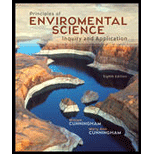
The food webs an individual belongs; to list the food eaten today and trace the energy it contained back to its photosynthetic source; whether the individual is at same trophic level in all the food webs in which he participated; The ways that could change the biological role; whether that make food available for other people; why or why not.
Answer to Problem 1AL
Humans do not fall into the same trophic level it depends on the food habit of an individual. Some are carnivores and some are omnivores. As result, plants get a chance to recover.
Explanation of Solution
Food web is a graphical representation of what an organism eats and what eats that organisms, it is an interconnected chain. At the base, the plant is kept as they are the primary producers, at the second herbivores are placed that feeds on green plants, at the third carnivores are placed, that eat animals and at the fourth level omnivores are kept that eats both plants and animals.
Humans fall into the third and fourth trophic level. This is because the food habit of humans differs, some are animals or meat eater and some eat both plants and animals. Humans that eat deer or cow fall under the third level in the trophic but there are also humans, who eat salmons that fall under the fourth level.
The diet of today’s include- rice, chicken, and rajma. Rice and rajma are the autotrophs that can make their own food. Where else the chickens are carnivores that eat both plants and small insects.
No, we are not at the same trophic level because if individuals eat meat (carnivores) then that individual falls under third trophic level but if an individual eats both plants and animal (omnivores) than that individual will fall under the fourth level.
Yes, there may be a change in the ecological role that can make food more available like if all humans fall in the same trophic level there be less number of plants available. But as some individuals are carnivores as well as omnivores, it provides a chance to the plants to recover. As a result, there will be more numbers of the plants.
Want to see more full solutions like this?
Chapter 2 Solutions
Principles of Environmental Science
 Applications and Investigations in Earth Science ...Earth ScienceISBN:9780134746241Author:Edward J. Tarbuck, Frederick K. Lutgens, Dennis G. TasaPublisher:PEARSON
Applications and Investigations in Earth Science ...Earth ScienceISBN:9780134746241Author:Edward J. Tarbuck, Frederick K. Lutgens, Dennis G. TasaPublisher:PEARSON Exercises for Weather & Climate (9th Edition)Earth ScienceISBN:9780134041360Author:Greg CarbonePublisher:PEARSON
Exercises for Weather & Climate (9th Edition)Earth ScienceISBN:9780134041360Author:Greg CarbonePublisher:PEARSON Environmental ScienceEarth ScienceISBN:9781260153125Author:William P Cunningham Prof., Mary Ann Cunningham ProfessorPublisher:McGraw-Hill Education
Environmental ScienceEarth ScienceISBN:9781260153125Author:William P Cunningham Prof., Mary Ann Cunningham ProfessorPublisher:McGraw-Hill Education Earth Science (15th Edition)Earth ScienceISBN:9780134543536Author:Edward J. Tarbuck, Frederick K. Lutgens, Dennis G. TasaPublisher:PEARSON
Earth Science (15th Edition)Earth ScienceISBN:9780134543536Author:Edward J. Tarbuck, Frederick K. Lutgens, Dennis G. TasaPublisher:PEARSON Environmental Science (MindTap Course List)Earth ScienceISBN:9781337569613Author:G. Tyler Miller, Scott SpoolmanPublisher:Cengage Learning
Environmental Science (MindTap Course List)Earth ScienceISBN:9781337569613Author:G. Tyler Miller, Scott SpoolmanPublisher:Cengage Learning Physical GeologyEarth ScienceISBN:9781259916823Author:Plummer, Charles C., CARLSON, Diane H., Hammersley, LisaPublisher:Mcgraw-hill Education,
Physical GeologyEarth ScienceISBN:9781259916823Author:Plummer, Charles C., CARLSON, Diane H., Hammersley, LisaPublisher:Mcgraw-hill Education,





